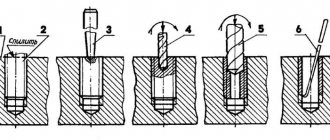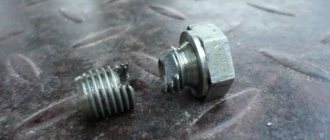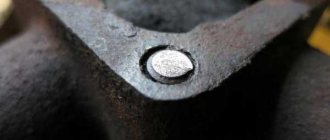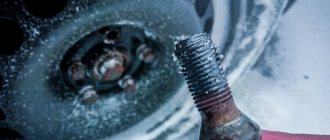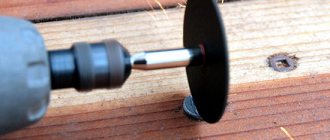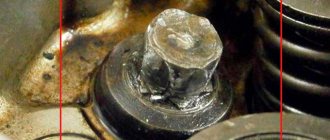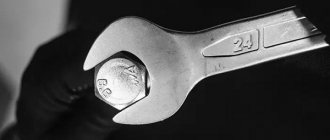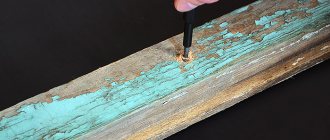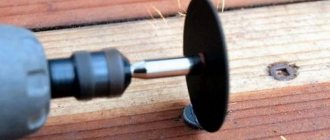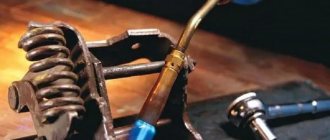How to unscrew a broken bolt using a drill with a left-hand spiral
In two stages:
- First you need to take a regular nozzle and center it.
- Then arm yourself with the one that rotates counterclockwise (let it be a little larger in diameter) and, using it, gradually remove the body.
You should be careful and control the direction of movement - then the edges of the working rod will catch the remaining hardware, pushing them upward, but without destroying the thread. If any damage occurs, it will be so minor that you can easily fix it with a tap. This method is effective when the fastening joint is not yet very rusty or stuck.
Simple option
The first thing to do is not to panic. At all. A broken bolt can almost always be removed, the main thing is to do it correctly.
Secondly, inspect the “scene of the incident.” If it breaks when unscrewing it, fill it with WD40, brilliant green or brake fluid - it is required that the broken piece is slid along the threads. You can try to anneal the threads with a blowtorch - you need to look at the circumstances. Let's see where it broke. When a broken piece sticks out above the part, you are very lucky - you can try to unscrew it. If this is possible, screw on two nuts, fixing the lower one with the upper one. We unscrew it by the bottom nut - if the broken bolt left the thread intact, it should come out. There is not enough space for two nuts - we try to unscrew them by the thread with pliers. Another way is to make a slot in the middle with a grinder. As a result, we get a screw that you can try to unscrew with a screwdriver. If it works, the problem is solved. But more often the bolt breaks either flush with the part or inside it.
Removing a Broken Bolt
If it is broken at the part level, try unscrewing it with your finger. In fact, when a broken bolt is inside the hole along the thread, it is clean, and the screw simply broke due to metal fatigue or because it was pulled earlier - it can simply go from a finger
Or we pay attention to the chip - when a piece breaks off, a side always forms on the fracture plane - we substitute a chisel, a screwdriver - we try to unscrew it with light blows
Such cases often occur when a non-threaded part is attached with a pin or bolt - for example, a manifold to a cylinder block.
Unscrewing a broken bolt using another
This method is suitable if the diameter of the residues is relatively large.
Because you will have to drill a smaller threaded hole in the body, into which you will then install a fastener with a left notch and begin to tighten it, going deeper and deeper - it will push out the previously destroyed part. The only downside is that a drill is required to complete the task, but it is not always at hand, and you will have to spend one new hardware. Therefore, it makes sense to consider solutions that are easier to implement and universal in everyday life, and put this aside in reserve for the case when there is no other option.
Preliminary actions
First, you should tap the remaining part with a punch and a hammer. This will help relieve the bolt from sagging.
You can use a torch to heat the part itself and the bolt to relieve internal stress. It is worth noting in this matter the main thing is not to overdo it and not melt the part and pain.
Use a lubricating fluid to better remove the bolt residue. In this case, WD-40 works well.
In this article we will tell you what you can use to unscrew broken bolts.
How to pull it out, drill it out and how to unscrew a broken bolt from a thread: the best methods
The choice of a specific method depends on the situation, but in practice, the fastening element we are considering most often turns out to be simply licked off (due to poor quality of workmanship). You can remove it without damaging the thread: to do this, just carefully sharpen the head so that its shape matches the size of the key. Well, if you want to minimize risks, you should additionally saturate the joint with lubricant - it will reduce the resistance to pulling.
Now let's pay attention to what to arm yourself with in the event of some kind of damage - due to rust, excessive pressure or for other reasons.
Flat head screwdriver and hammer
This is how to unscrew a broken bolt when the break occurs above the thread surface and the edge of the resulting surface is uneven. Here you need:
- Clean the contact area, examine it carefully and find the largest protrusion.
- Place the tool at the selected point, placing it at an angle; It is quite acceptable to deepen the uneven area with a core so that you can rest even more reliably.
- Try to turn the hardware using light blows; If it doesn’t work, increase the force of influence a little at a time until it works.
Of course, this method should be implemented with extreme caution so as not to accidentally damage adjacent elements or make the hole too deep.
Unscrew with a chisel
Another option for unscrewing is to drill out a broken bolt and remove the broken piece from a hole in a hard-to-reach place. It is carried out using the same technology as the previous one: they cleared the place, found a point of emphasis, and began to turn. Moreover, the remainder should be unscrewed quite easily and quickly, because the contact area of the tool in this case is larger than in the past.
Excellent for removing hardware with the top flying off.
Core and hammer
A suitable choice when the head has been torn off or if a defect is discovered at the very beginning of the thread, and there is no screwdriver at hand. Look, the tip of the marking tool is sharp and therefore excellent for deforming the cut. A few light blows, and the surface is no longer flat; you can grab onto it with pliers and pull out the stuck body.
Weld the nut by welding
Let's imagine that the head of a bolt is broken: how to unscrew the remaining part?
An original but effective solution is to attach something to it that you can pull on. A hollow fastener with a similar thread is an ideal option, but how to fix it? Using heat treatment with plastic deformation! To solve this, in addition to the element already mentioned, you need to take more wire cutters, and also connect a welding machine and:
- Take the nut with a holder and lean it against the fragment with a slight offset.
- Connect the body to the part using an arc.
Now it will not be difficult to remove the failed hardware and replace it.
Also, as an alternative, you can weld the pin - at an angle, and small. It will perfectly serve as a lever that can be pulled to remove the body.
When deciding how to remove and unscrew the remains of a bolt if it has broken off, many people prefer welding - because it has at least 3 advantages:
- You can start unscrewing almost without delay, since the same nut heats up strongly and quickly; and this does not harm the body of the part, because it continues to remain cold. Also, due to thermal expansion, decoking of the stuck contact is observed.
- Using this method, it will not be difficult to remove even fragments of hardened hardware made of high-strength steel, drilling which is very time-consuming, difficult and impractical.
- A strong seam is created between the body and the lever (consumable), which allows you to pull out the worn element with pliers even with force.
Welding is also a convenient answer to the question of how to remove a broken bolt from a thread, because it allows you to unscrew any remaining hardware - protruding from the body, running flush, and even deeply recessed. In the first and second cases, you can attach a washer with a nut or a lever and pull, in the third - insert a metal tube and build it up - there are options, and each of them is quite simple to implement.
Unscrew the pin using an extractor
This is a specialized tool, and it is effective where available tools fail.
Previously, it was wedge-shaped (a cone with special edges) or rod-shaped, and both of these options were driven into holes. Its screw model, with a cut spiral, has also gained popularity. Today it is a whole set of devices, which includes bushings, drills and metal strips. So, you have a kink in the bolt, how to unscrew it using this device:
- Fill the contact area with lubricant or, if the connection is old and stuck, with a rust solvent.
- Make a hole (the same diameter as the damaged fastener), using one of the supplied tubes as a guide.
- Drive the rod to the wedging depth.
- Remove the tool element along with the remains of the body using a wrench.
After this, you just need to place the worn hardware on a hard surface and lightly hit it several times to loosen the contact force and remove it from the working part of the tool.
The method of how to unscrew a crimp with an extractor may differ slightly depending on where exactly the fastener managed to break off:
- Above/below the engine housing (or other functional unit) - you need to install a guide, drill a hole, hammer a rod into it, and remove the damaged element.
- Flush with the surface - you should also use a punch for centering; and when you mark the point for the location of the sleeve, all that remains is to repeat the above operations.
Universal sets are good because they can be used to remove not only hardware, but also screws and even thin studs. They are quite affordable in price, and when purchasing, it is better to give preference to extractors made of hardened or chrome vanadium steel - they are stronger.
How to properly drill out a broken bolt body in a hard-to-reach place
This is one of the most labor-intensive ways to remove a broken bolt from a thread, and it is worth using it in practice only when there are no other options. And not only because it takes time, it is important to maintain the accuracy of the work. The slightest mistake and the internal coils of the case will be damaged. In addition, to implement the method you will need a whole set of tools:
- Metal drill with a set of attachments.
- Screwdrivers with different blades.
- Triangular file
- Reliable pliers or, better yet, a wrench.
- Tap.
- Several needle files of various shapes and sizes.
WD-40 will also be useful: we remind you that it is worth pouring it into the work area 15 minutes before performing operations, it will dissolve some of the rust.
So, the bolt has broken off, how to unscrew the broken part from the thread using drilling:
- Put on the thinnest attachment, turn on the drill and make a recess exactly in the center of the hardware; try not to go aside, this is fraught with subsequent difficulties.
- Change drills, gradually increasing their cross-section, until the hole occupies 1/3 of the diameter of the body.
- Drive the file in, carefully but firmly, because if it does not hold well, you will not be able to remove the damaged element.
- Take pliers or a gas wrench, clamp the trihedron with them and begin to make circular movements, trying to pull out the fasteners.
It should work, but how to unscrew and remove the broken part, how to unscrew a broken bolt if it does not give in even after all these steps? It is necessary to widen the hole so that another hardware fits into it, but smaller and with the opposite thread (usually the left one). In this case, the second one will act as a cap after it is screwed into the first one.
If this doesn’t work, just continue to increase the diameter and length of the recess until the pressure on the remaining fastening element weakens, then they will begin to wobble and it will not be difficult to remove them using a suitable tap.
We remind you that this is a solution for extreme cases; in general, there are simpler, faster, more convenient options.
Flush break
This type of failure is considered the most difficult to repair, since it is very difficult to determine the diameter of the hole, especially when cutting fasteners. Therefore, in order to drill out a broken bolt of a certain type, it is necessary to clean the surface. This will allow us to determine the gaps we need.
The following unpleasant situation often occurs: the breakage site has curved shapes that are very difficult to process and straighten. And it is categorically not recommended to drill a product in such a state, because there is a risk of completely ruining the structure. Therefore, you first need to use a core, which is used to prepare a place in the center of the drill.
The further procedure for drilling out a bolt that has broken in one way or another is similar to the option for a surface break. After creating the hole, the remaining threads are removed using a hook.
How to remove a bolt if it is broken and nothing helps or the thread is already badly damaged
In such a difficult situation, you should drill a hole so that its width is sufficient for cutting new turns. Although the hardware may be hardened and difficult to give in. Then it must be subjected to heat - heated red-hot - and then left to cool. It is strictly forbidden to forcibly cool it with water - too sharp a temperature rise will only lead to the appearance of cracks.
The operation of slowly changing the temperature regime must be carried out several times. Due to this, the metal will be tempered and slightly softened, and the damaged element will become easier to drill out. But if the body of the part (unit, functional unit) is made of aluminum, special care should be taken to ensure that the surface in the heating zone does not warp.
Unscrew the pin using an extractor
If available methods are not suitable, you should use a specialized tool. It's called an extractor and is usually sold as a whole set. You can also unscrew a bolt with licked edges using it.
First you need to use a core to mark the center. This is necessary to ensure that the trajectory does not change during drilling. We choose a drill with a diameter smaller than the pin, but corresponding to the extractor. Make a hole and insert the extractor.
Unscrew the bolt with extreme caution, as the integrity of the thread has decreased, which can lead to a break.
A torn hat can be reattached
This is a method from the “need for invention is cunning” category. We take a nut whose diameter is at least 1 millimeter larger than the diameter of the rod and simply weld it to the fragment. During welding, the metal must warm up properly and expand. We connect the rod and the nut, we get a knot that needs to be watered. When the assembly has cooled, you can carefully unscrew the fragment.
Thus, we learned what methods exist for removing broken fasteners. We hope that they will help you solve this small but annoying problem that sometimes arises in the practice of home craftsmen. But it is better that you get strong and unbreakable bolts, studs and screws.
Note: Viega installation
Flat head screwdriver and hammer
This method will give a positive result if the bolt breaks above the thread and there are irregularities on the surface. Then a handy set of tools for repair work of any complexity will come in handy.
On the cleaned surface of the fragment we find the largest protrusion. Take a flat-head screwdriver and place it at an angle, pressing it to the desired location.
Check it out here too!
- Replacing a pressure tap - a step-by-step description of how to change a pressure tap with your own hands (80 photos + video)
- What is an acoustic switch: device, operation, types and features of the device (100 photos)
- Low and high pass filter: making frequency filters and how to create high-end circuitry (95 photos + video)
For strong support, use a core, which makes the uneven surface deeper. Then, using gentle pushes, carefully turn the thread. If necessary, the emphasis on the surface can be increased.
